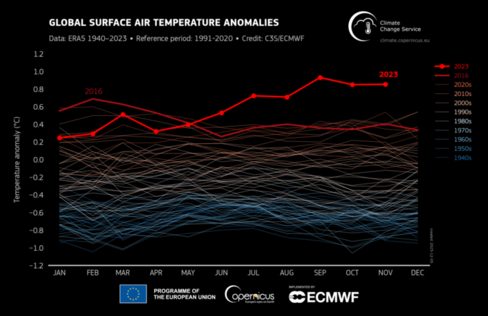
Water Conservation: 7 Simple Ways to Save Water at Home and in Your Business
Water is one of our most precious resources, yet it is often wasted without thought. ...

The Copernicus Climate Change Service (C3S) said 2023 is the warmed year in recorded history and that the world is risking reaching 1.5°C by February 2034.
“2023 has now had six record breaking months and two record breaking seasons. The extraordinary global November temperatures, including two days warmer than 2°C above preindustrial, mean that 2023 is the warmest year in recorded history.” said Samantha Burgess, Deputy Director of the Copernicus Climate Change Service (C3S). C3S Director, Carlo Buontempo adds: “As long as greenhouse gas concentrations keep rising, we can’t expect different outcomes from those seen this year. The temperature will keep rising and so will the impacts of heatwaves and droughts. Reaching net zero as soon as possible is an effective way to manage our climate risks.”
When the Paris Agreement was signed, in December 2015, the world was projected to reach the 1.5°C threshold by March 2045. On the 8th anniversary of its signature, we risk breaching that benchmark by February 2034, according to data extrapolation based on Copernicus Climate Change Service data.
Time is shrinking if the world wants to keep the global temperatures below 1.5°C compared with the pre-industrial average. An application developed by C3S shows it very clearly. In 2015, when COP delegates signed the Paris accord, C3S data estimated that the global temperature was 0.98°C above the pre-industrial average and would have breached the 1.5°C threshold in 2045. Today, as delegates address the first global stocktake, a critical inventory of the Paris Agreement actions and commitments to assess the progress made, the same data estimates that we have reached a global average of 1.25°C and will be at 1.5°C over pre-industrial levels in 2034. And this extrapolation, doesn’t take into account the record temperatures of November.
The 1.5ºC application shows that the window in time to reach 1.5°C closed rapidly between 2015 and 2021, linked to a combinations of events – a series of record warm years; high GHG emissions and natural variability. Since then, the distance to the 1.5°C threshold has remained at around 12 years from present. These extrapolations into the future give us an estimate of the pace of anthropogenic global warming and the closing window for climate action to keep global climate below 1.5ºC.
The app uses C3S’ ERA5 data. It takes the timeseries of global surface air temperature data, extrapolated with a simple linear regression, showing when the central point would reach 1.5°C over pre-industrial in a 30-year average. The estimate is updated monthly.
Although extremely concerning, this outcome is unsurprising given the continued increase in greenhouse gas concentrations in the atmosphere that, according to all expectations, will mark new heights this year. Since global leaders committed to the Paris Agreement there has been limited visible deceleration of the trend.
It is not all bad news, some sectors and regions have adapted considerably. The Copernicus Atmosphere Monitoring Service (CAMS) provides near-real-time estimates of CO2 emissions for the European Union and the UK in partnership with Carbon Monitor. Some sectors have reduced emissions significantly, but these efforts don’t translate into a global decrease in concentrations.
Eventually our 1.5°C app also shows the astonishing broken records of the year 2023 qualified as a “cacophony of broken records.” (WMO) or “a year of broken records” (UNEP).
The years since the signature of the Paris Agreement have been the warmest in climate data records dating back to 1940, but the difference of 2023 stands out very clearly.
اترك تعليقا